Real-Time Integrated Energy Management Strategy Applied to Fuel Cell Hybrid Systems
Abstract
1. Introduction
- Provide a systematic and methodological approach to the design of complex EMSs (i.e., the iEMS framework: a new paradigm);
- Improve fuel consumption using the optimization concept;
- Be adapted to real-time driving conditions (stochastic behavior, possibility of integrating other constraints from the cooperative environment);
- To integrate the challenging fuel cell system into the electric vehicle (slow dynamic, downsizing, etc.).
2. Related Works
- -
- OBS to meet the EMS central objective (i.e., consumption reduction);
- -
- RBS to adapt the OBS online;
- -
- LBS to adapt the RB-OBS to the environment stochastic behavior.
2.1. The Optimization-Based Strategy (OBS) Challenges
2.2. Learning-Based Strategy (LBS) Integration
2.3. Rule-Based Strategy (RBS) and Engineering Intuition
- -
- Combine the vehicle state expert knowledge with the hybrid control strategy;
- -
- Adapt the PMP algorithm according to the new battery usage engineering intuition.
2.4. Research Gap
2.5. The iEMS Concept: Combining the Three Families of Algorithms
2.6. Our iEMS Proposition
3. Integrated Energy Management Strategy iEMS Development
3.1. System Modeling
- Vehicle Modeling
- Battery Modeling
- Fuel Cell System Modeling
3.2. iEMS Global Architecture
3.3. The OBS: Online PMP
3.3.1. Optimization Problem Formulation
- State equation
- Local state and control variable constraints
- Boundary conditions
- Performance index and cost function
- Optimization problem formulation
3.3.2. Online Pontryagin’s Minimum Principle
- Hamiltonian function
- PMP online algorithm
| Algorithm 1. The proposed online PMP algorithm operation on a sliding window |
If above and go to Step 2. If yes: output the optimal command vector. |
3.4. The RBS: Expert Rules and Fuzzy Inference System
3.4.1. Expert Rules
- (i)
- The control variable boundaries on each time step of each sliding window;
- (ii)
- The battery power boundaries on each time step using (i) in Equation (3);
- (iii)
- The maximum variation in the SOC according to the real-time battery power boundaries using (ii) results in Equation (4) and by applying, if necessary, the constraints Equation (11).
- Control variable boundaries:
- Local constraints on the battery power: prohibit wasting energy or having to supply too much power:where and are, respectively, the dynamic lower and upper battery power boundaries, and and are the lower and upper battery power global boundaries.
3.4.2. Fuzzy Inference System
- Inputs Fuzzification
- Fuzzy Logic Controller Strategy
3.5. The LBS: Driving Pattern Recognizer Designed for FCHEVs
3.5.1. Fuzzy C-Means Classification of the Driving Patterns
- Database processing
- Data standardization
- Classification
3.5.2. Online Driving Pattern Recognizer
4. Results and Discussion
4.1. The Driving Pattern Recognizer LBS
4.2. Battery Usage RBS
4.3. The iEMS Results
4.4. Discussion
5. Conclusions
Author Contributions
Funding
Data Availability Statement
Conflicts of Interest
Abbreviations
| Acronym | Meaning |
| EMS | Energy management strategy |
| OBS | Optimization-based strategy |
| RBS | Rule-based strategy |
| LBS | Learning-based strategy |
| SOC | (Battery) state of charge |
| FCS | Fuel cell system |
| FCHEV | Fuel cell hybrid electric vehicle |
| HESS | Hybrid energy storage system |
| DP | Dynamic programming |
| PMP | Pontryaguin minimum principle |
| ECMS | Equivalent consumption minimization strategy |
| LHV | Lower heating value |
References
- Sorlei, I.-S.; Bizon, N.; Thounthong, P.; Varlam, M.; Carcadea, E.; Culcer, M.; Iliescu, M.; Raceanu, M. Fuel cell electric vehicles—A brief review of current topologies and energy management strategies. Energies 2021, 14, 252. [Google Scholar] [CrossRef]
- Tran, D.-D.; Vafaeipour, M.; El Baghdadi, M.; Barrero, R.; Van Mierlo, J.; Hegazy, O. Thorough state-of-the-art analysis of electric and hybrid vehicle powertrains: Topologies and integrated energy management strategies. Renew. Sustain. Energy Rev. 2020, 119, 109596. [Google Scholar] [CrossRef]
- Luo, Y.; Wu, Y.; Li, B.; Qu, J.; Feng, S.-P.; Chu, P.K. Optimization and cutting-edge design of fuel-cell hybrid electric vehicles. Int. J. Energy Res. 2021, 45, 18392–18423. [Google Scholar] [CrossRef]
- Azib, T.; Larouci, C.; Chaibet, A.; Boukhnifer, M. Online energy management strategy of a hybrid fuel cell/battery/ultracapacitor vehicular power system. IEEJ Trans. Electr. Electron. Eng. 2014, 9, 548–554. [Google Scholar] [CrossRef]
- Ritzberger, D.; Hametner, C.; Jakubek, S. A real-time dynamic fuel cell system simulation for model-based diagnostics and control: Validation on real driving data. Energies 2020, 13, 3148. [Google Scholar] [CrossRef]
- Zhang, F.; Wang, L.; Coskun, S.; Pang, H.; Cui, Y.; Xi, J. Energy management strategies for hybrid electric vehicles: Review, classification, comparison, and outlook. Energies 2020, 13, 3352. [Google Scholar] [CrossRef]
- Zhang, F.; Hu, X.; Langari, R.; Cao, D. Energy management strategies of connected HEVs and PHEVs: Recent progress and outlook. Prog. Energy Combust. Sci. 2019, 73, 235–256. [Google Scholar] [CrossRef]
- Jalil, N.; Kheir, N.A.; Salman, M. A rule-based energy management strategy for a series hybrid vehicle. In Proceedings of the 1997 American Control Conference (Cat. No. 97CH36041), Albuquerque, NM, USA, 4–6 June 1997; pp. 689–693. [Google Scholar]
- Erdinc, O.; Vural, B.; Uzunoglu, M. A wavelet-fuzzy logic based energy management strategy for a fuel cell/battery/ultra-capacitor hybrid vehicular power system. J. Power Sources 2009, 194, 369–380. [Google Scholar] [CrossRef]
- Salmasi, F.R. Control strategies for hybrid electric vehicles: Evolution, classification, comparison, and future trends. IEEE Trans. Veh. Technol. 2007, 56, 2393–2404. [Google Scholar] [CrossRef]
- Majed, C.; Karaki, S.H.; Jabr, R. Neural Network Technique for Hybrid Electric Vehicle Optimization. In Proceedings of the 2016 18th Mediterranean Electrotechnical Conference (MELECON), Lemesos, Cyprus, 18–20 April 2016. [Google Scholar]
- Matthieu, M.; Toufik, A.; Mehdi, M.; Chaibet, A. Real-time and multi-layered energy management strategies for fuel cell electric vehicle overview. In Proceedings of the 2022 IEEE 95th Vehicular Technology Conference:(VTC2022-Spring), Helsinki, Finland, 19–22 June 2022; pp. 1–6. [Google Scholar]
- Steinstraeter, M.; Buberger, J.; Trifonov, D. Battery and Heating Data in Real Driving Cycles. IEEE Dataport 2020. [Google Scholar] [CrossRef]
- Liu, J.; Chen, Y.; Li, W.; Shang, F.; Zhan, J. Hybrid-Trip-Model-Based Energy Management of a PHEV With Computation-Optimized Dynamic Programming. IEEE Trans. Veh. Technol. 2017, 67, 338–353. [Google Scholar] [CrossRef]
- Larsson, V.; Johannesson, L.; Egardt, B. Analytic Solutions to the Dynamic Programming Subproblem in Hybrid Vehicle Energy Management. IEEE Trans. Veh. Technol. 2014, 64, 1458–1467. [Google Scholar] [CrossRef]
- Gong, Q.; Li, Y.; Peng, Z.-R. Trip-Based Optimal Power Management of Plug-in Hybrid Electric Vehicles. IEEE Trans. Veh. Technol. 2008, 57, 3393–3401. [Google Scholar] [CrossRef]
- Yazdani, A.; Bidarvatan, M. Real-Time Optimal Control of Power Management in a Fuel Cell Hybrid Electric Vehicle: A Comparative Analysis. SAE Int. J. Altern. Powertrains 2018, 7, 43–54. [Google Scholar] [CrossRef]
- Liu, J.; Chen, Y.; Zhan, J.; Shang, F. An On-Line Energy Management Strategy Based on Trip Condition Prediction for Commuter Plug-In Hybrid Electric Vehicles. IEEE Trans. Veh. Technol. 2018, 67, 3767–3781. [Google Scholar] [CrossRef]
- Le Rhun, A. Stochastic Optimal Control for the Energy Management of Hybrid Electric Vehicles under Traffic Constraints. Ph.D. Thesis, Université Paris Saclay, Gif-sur-Yvette, France, 2019. [Google Scholar]
- Du, C.; Huang, S.; Jiang, Y.; Wu, D.; Li, Y. Optimization of Energy Management Strategy for Fuel Cell Hybrid Electric Vehicles Based on Dynamic Programming. Energies 2022, 15, 4325. [Google Scholar] [CrossRef]
- Boltyanskiy, V.G.; Gamkrelidze, R.V.; Pontryagin, L.S. Theory of Optimal Processes; Joint Publications Research Service: Arlington, VA, USA, 1961. [Google Scholar]
- Geering, H.P. Optimal Control with Engineering Applications; Springer: Berlin/Heidelberg, Germany, 2007. [Google Scholar]
- Kim, N.; Cha, S.; Peng, H. Optimal Control of Hybrid Electric Vehicles Based on Pontryagin’s Minimum Principle. IEEE Trans. Control. Syst. Technol. 2010, 19, 1279–1287. [Google Scholar]
- Paganelli, G. Conception et Commande d’une Chaîne de Traction pour Véhicule Hybride Parallèle Thermique et Électrique. Ph.D. Thesis, Université de Valenciennes, Valenciennes, France, 1999. [Google Scholar]
- Onori, S.; Serrao, L.; Rizzoni, G. Hybrid Electric Vehicles: Energy Management Strategies; Springer: Berlin/Heidelberg, Germany, 2016. [Google Scholar]
- Xie, S.; Hu, X.; Qi, S.; Lang, K. An artificial neural network-enhanced energy management strategy for plug-in hybrid electric vehicles. Energy 2018, 163, 837–848. [Google Scholar] [CrossRef]
- Li, H.; Zhou, Y.; Xiong, H.; Fu, B.; Huang, Z. Real-Time Control Strategy for CVT-Based Hybrid Electric Vehicles Considering Drivability Constraints. Appl. Sci. 2019, 9, 2074. [Google Scholar] [CrossRef]
- Li, H.; Ravey, A.; N’Diaye, A.; Djerdir, A. Online adaptive equivalent consumption minimization strategy for fuel cell hybrid electric vehicle considering power sources degradation. Energy Convers. Manag. 2019, 192, 133–149. [Google Scholar] [CrossRef]
- Zhou, Y.; Ravey, A.; Péra, M.-C. A survey on driving prediction techniques for predictive energy management of plug-in hybrid electric vehicles. J. Power Sources 2018, 412, 480–495. [Google Scholar] [CrossRef]
- Montazeri, M.; Fotouhi, A.; Naderpour, A. Driving segment simulation for determination of the most effective driving features for HEV intelligent control. Veh. Syst. Dyn. 2012, 50, 229–246. [Google Scholar] [CrossRef]
- Zhang, S.; Xiong, R. Adaptive energy management of a plug-in hybrid electric vehicle based on driving pattern recognition and dynamic programming. Appl. Energy 2015, 155, 68–78. [Google Scholar] [CrossRef]
- Lin, C.-C.; Jeon, S.; Peng, H.; Lee, J.M. Driving Pattern Recognition for Control of Hybrid Electric Trucks. Veh. Syst. Dyn. 2004, 42, 41–58. [Google Scholar] [CrossRef]
- Kim, N.; Rousseau, A. Sufficient conditions of optimal control based on Pontryagin’s minimum principle for use in hybrid electric vehicles. Proc. Inst. Mech. Eng. Part D J. Automob. Eng. 2012, 226, 1160–1170. [Google Scholar] [CrossRef]
- Saiteja, P.; Ashok, B. Critical review on structural architecture, energy control strategies and development process towards optimal energy management in hybrid vehicles. Renew. Sustain. Energy Rev. 2022, 157, 112038. [Google Scholar] [CrossRef]
- Zhao, X.; Wang, L.; Zhou, Y.; Pan, B.; Wang, R.; Wang, L.; Yan, X. Energy management strategies for fuel cell hybrid electric vehicles: Classification, comparison, and outlook. Energy Convers. Manag. 2022, 270, 116179. [Google Scholar] [CrossRef]
- Ceschia, A.; Azib, T.; Bethoux, O.; Alves, F. Multi-Criteria Optimal Design for FUEL Cell Hybrid Power Sources. Energies 2022, 15, 3364. [Google Scholar] [CrossRef]
- Saldaña, G.; Martín, J.I.S.; Zamora, I.; Asensio, F.J.; Oñederra, O. Analysis of the Current Electric Battery Models for Electric Vehicle Simulation. Energies 2019, 12, 2750. [Google Scholar] [CrossRef]
- Wang, T.; Jia, G.; He, S.; Lei, N.; Kang, Z.; Zou, D.; Zhang, Q.; Kou, W.; Xia, L. Experimental Study on The Performance of FCV in Standard Test Cycle. IOP Conf. Ser. Earth Environ. Sci. 2021, 632, 032014. [Google Scholar] [CrossRef]
- Sery, J.; Leduc, P. Fuel cell behavior and energy balance on board a Hyundai Nexo. Int. J. Engine Res. 2021, 23, 709–720. [Google Scholar] [CrossRef]


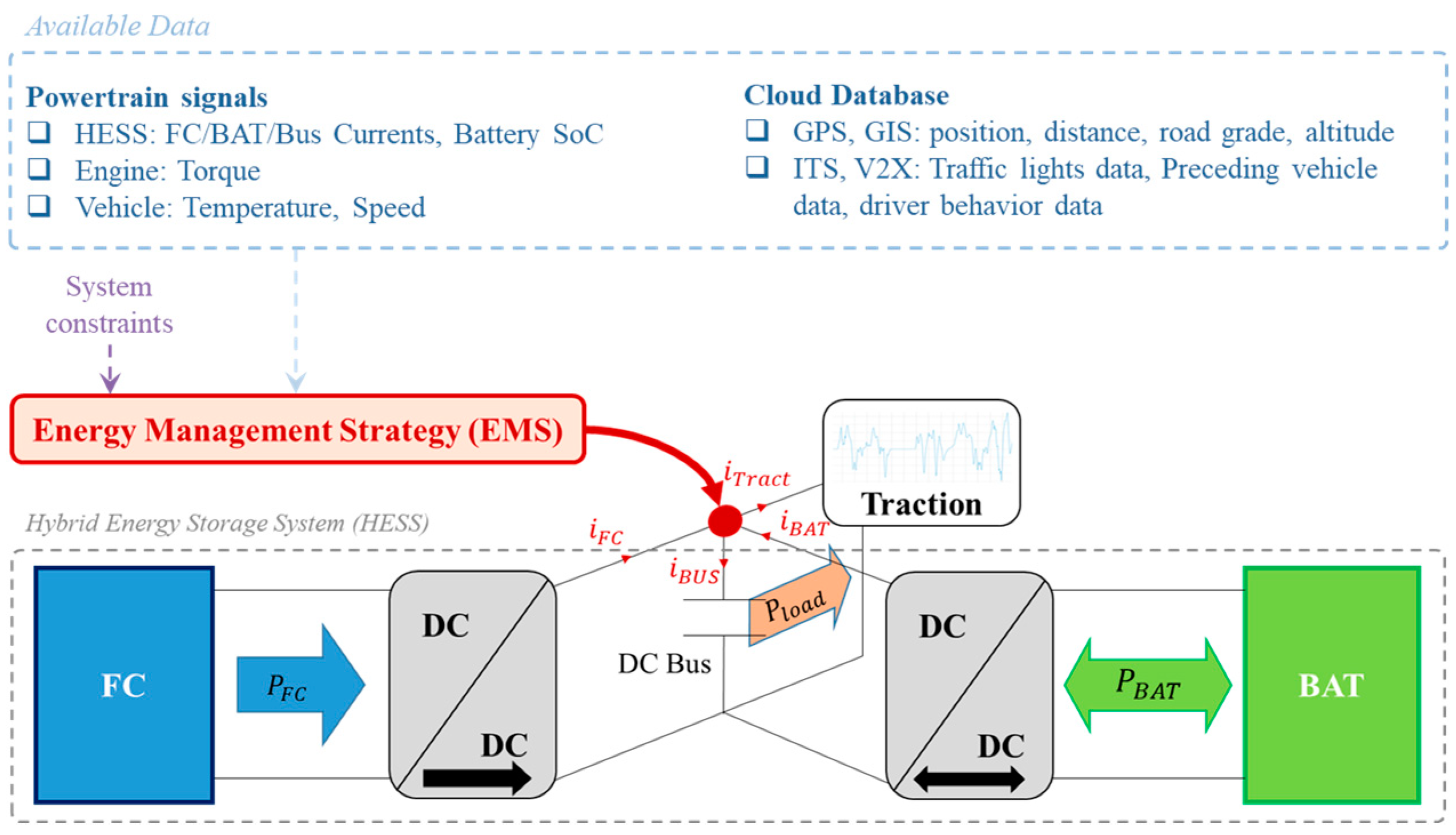
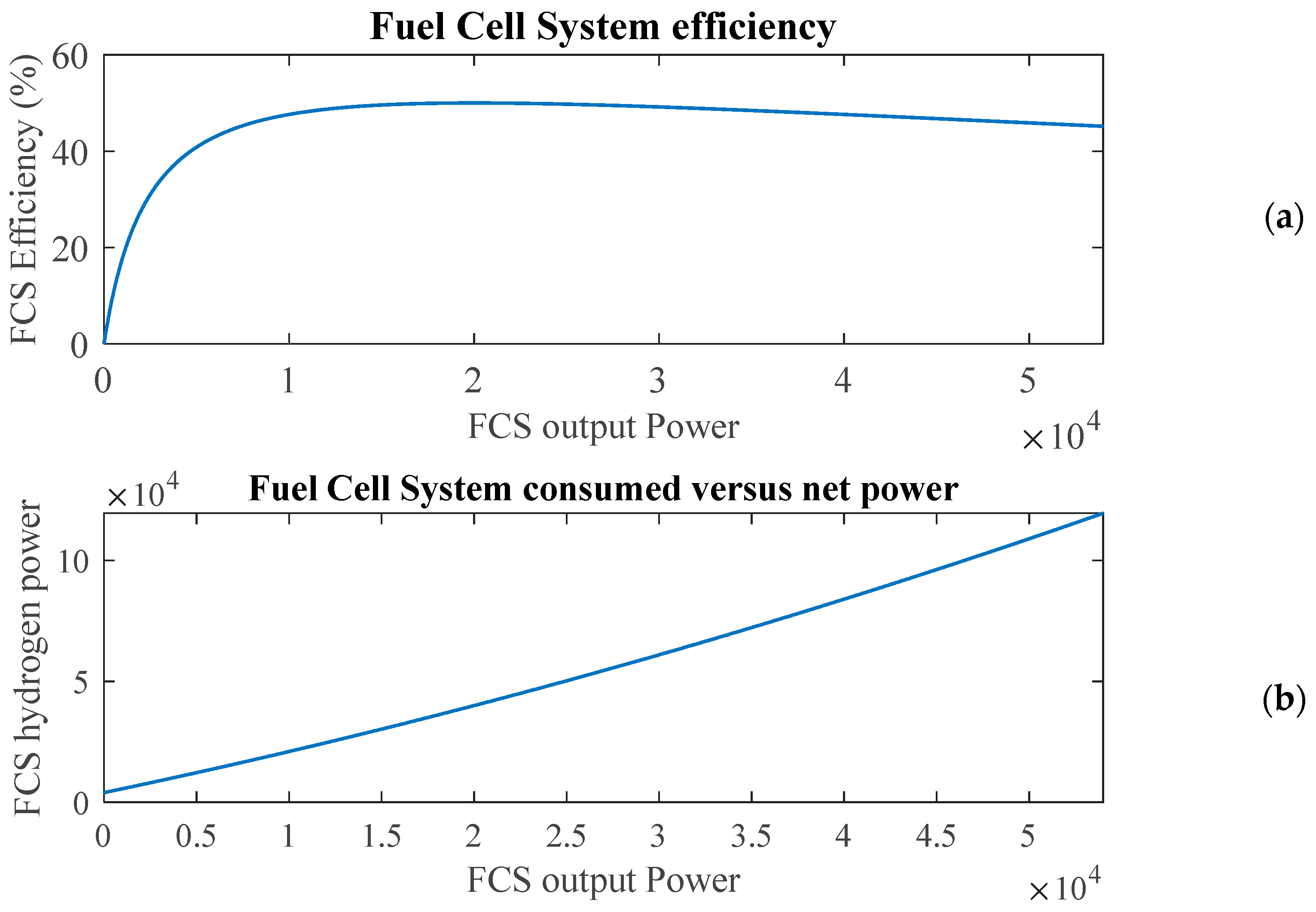

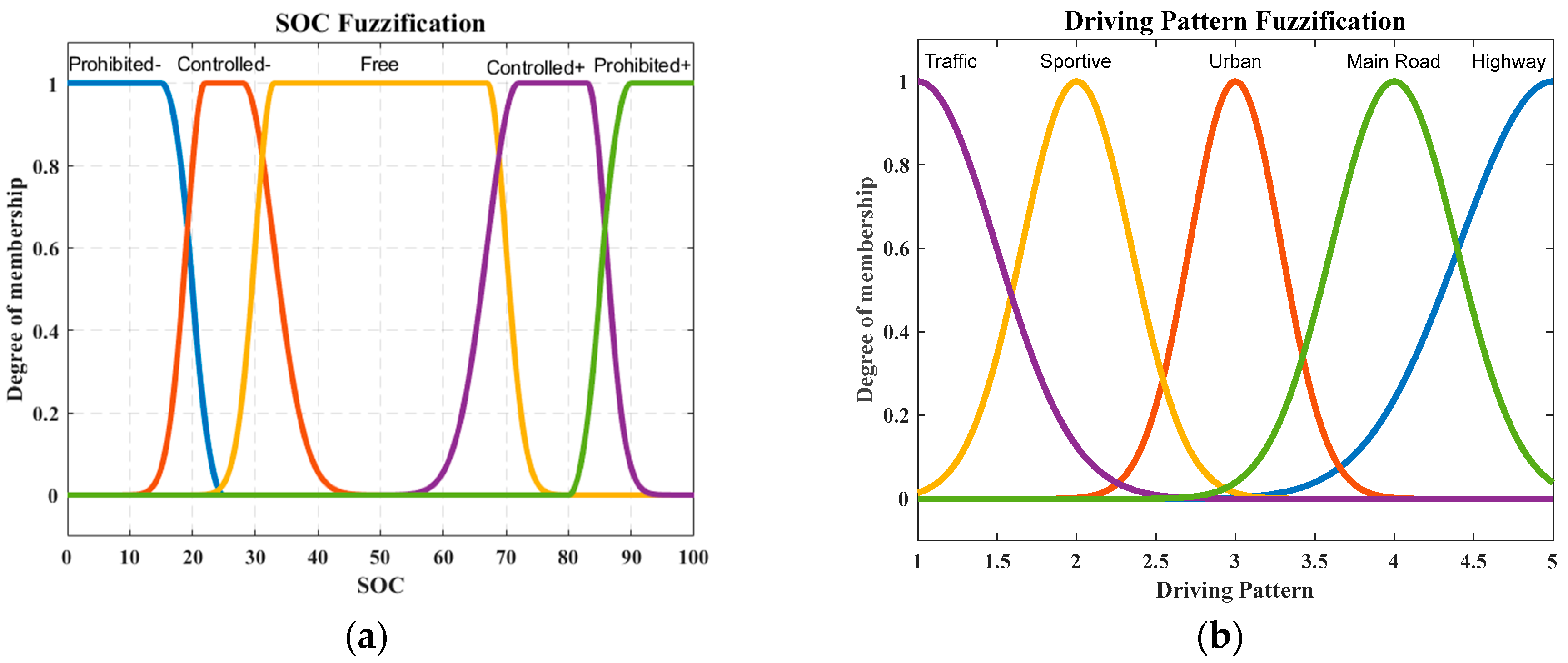


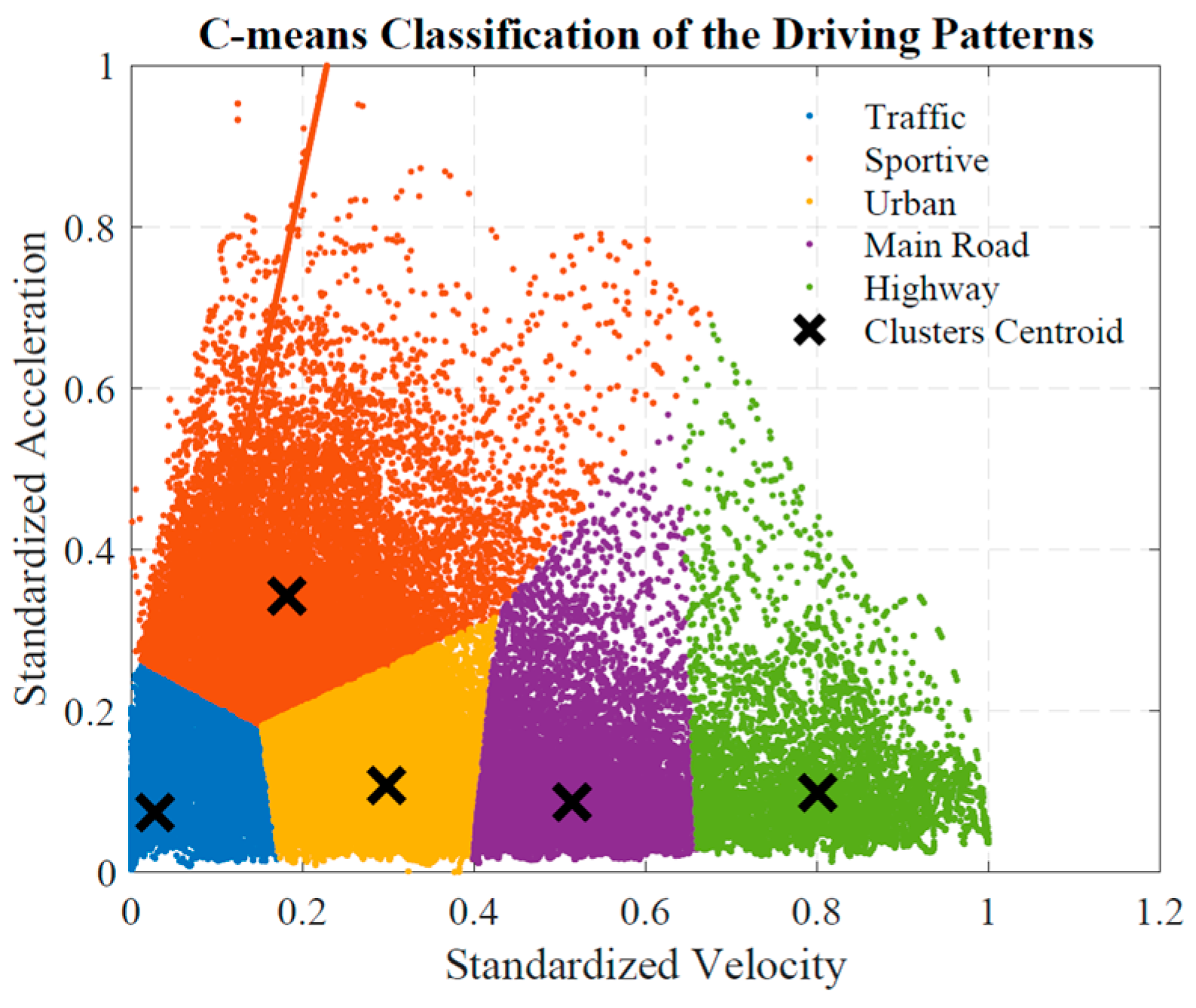
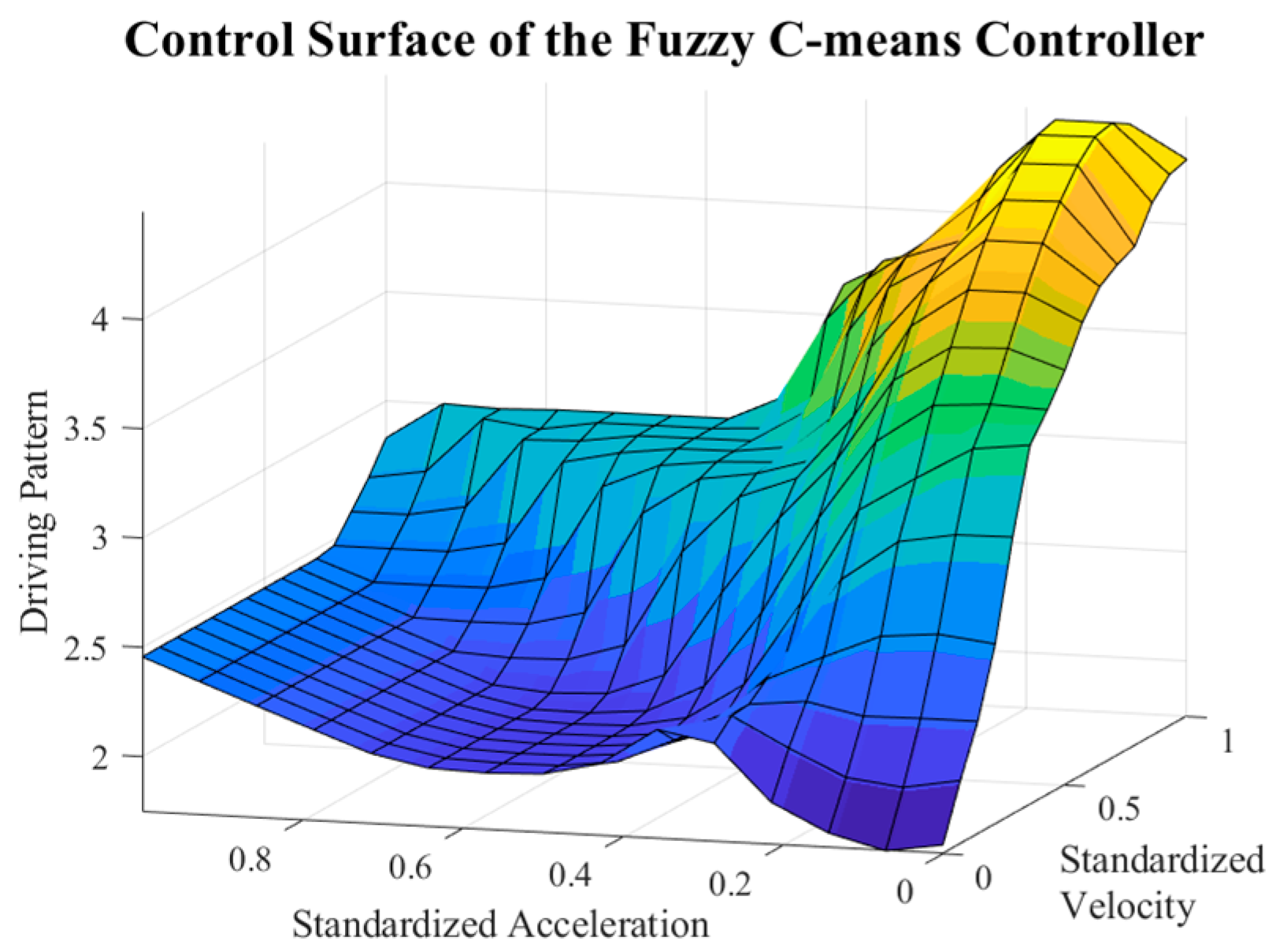
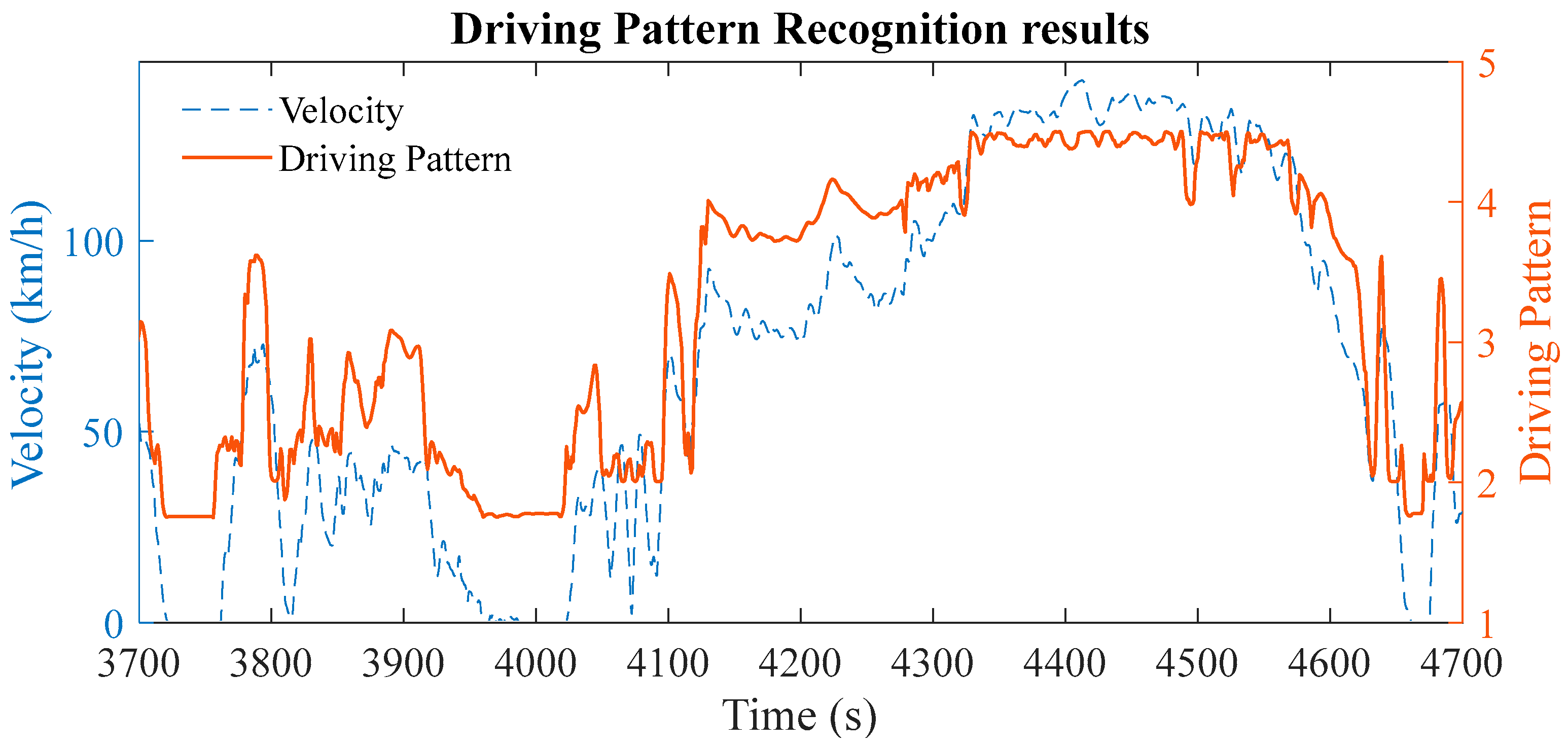
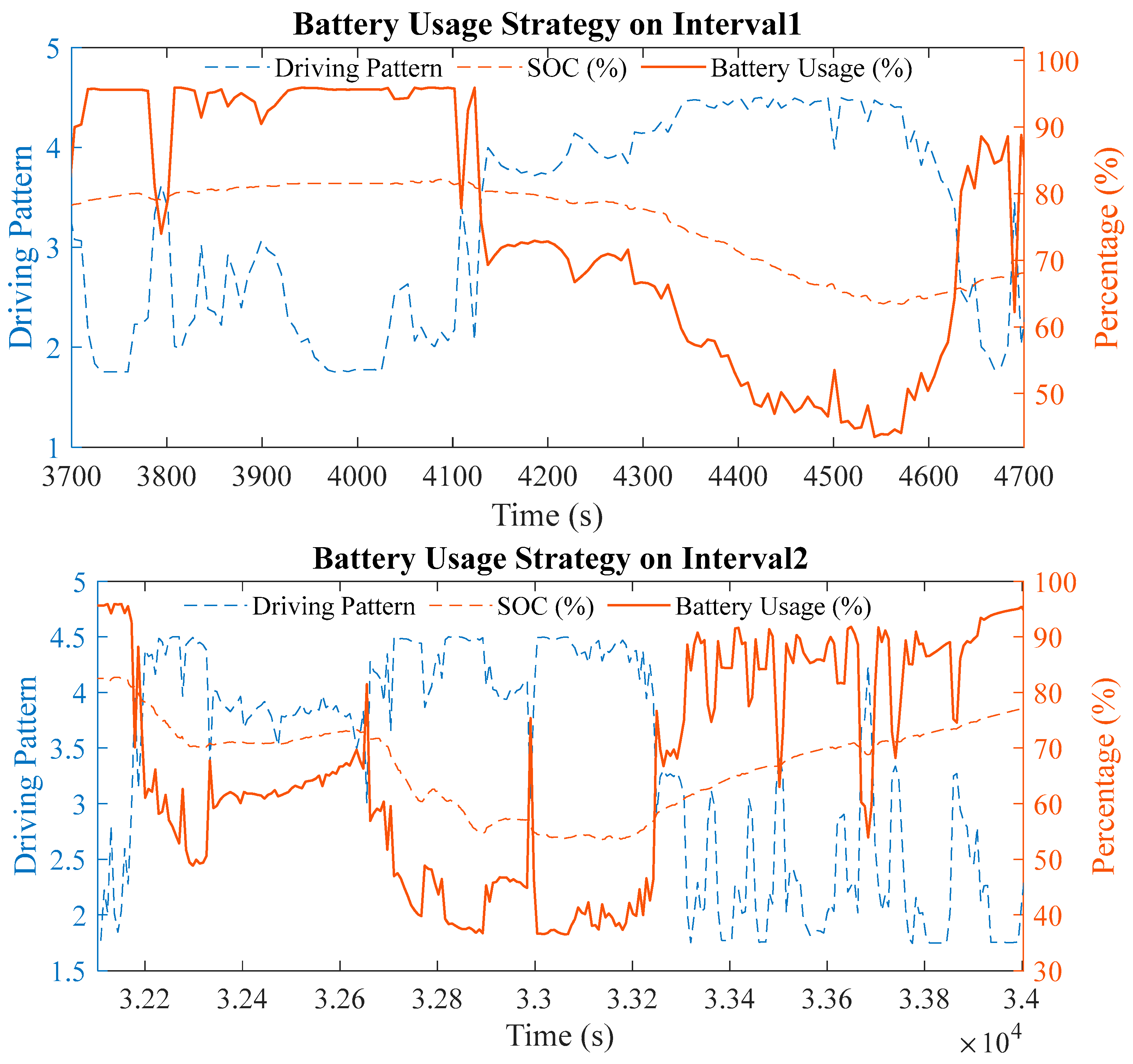
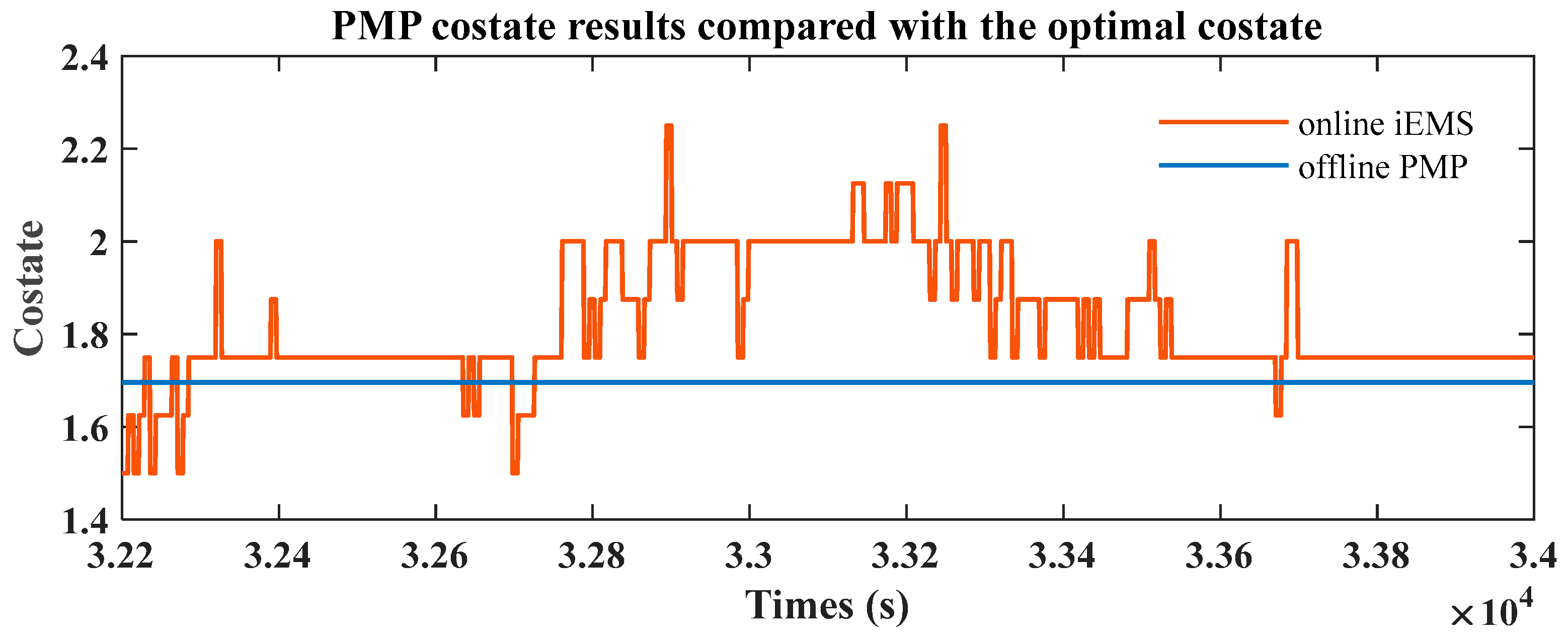
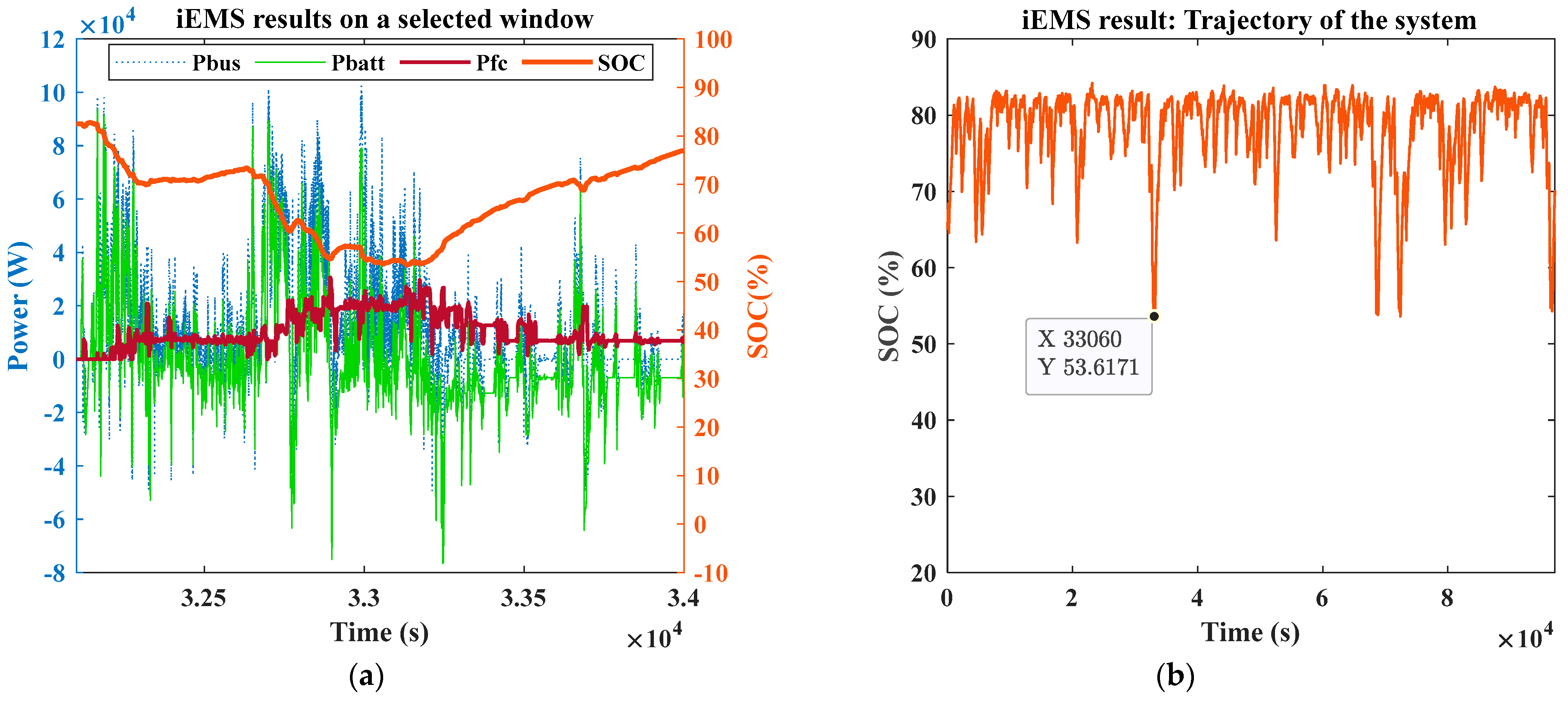
Disclaimer/Publisher’s Note: The statements, opinions and data contained in all publications are solely those of the individual author(s) and contributor(s) and not of MDPI and/or the editor(s). MDPI and/or the editor(s) disclaim responsibility for any injury to people or property resulting from any ideas, methods, instructions or products referred to in the content. |
© 2023 by the authors. Licensee MDPI, Basel, Switzerland. This article is an open access article distributed under the terms and conditions of the Creative Commons Attribution (CC BY) license (https://creativecommons.org/licenses/by/4.0/).
Share and Cite
Matignon, M.; Azib, T.; Mcharek, M.; Chaibet, A.; Ceschia, A. Real-Time Integrated Energy Management Strategy Applied to Fuel Cell Hybrid Systems. Energies 2023, 16, 2645. https://doi.org/10.3390/en16062645
Matignon M, Azib T, Mcharek M, Chaibet A, Ceschia A. Real-Time Integrated Energy Management Strategy Applied to Fuel Cell Hybrid Systems. Energies. 2023; 16(6):2645. https://doi.org/10.3390/en16062645
Chicago/Turabian StyleMatignon, Matthieu, Toufik Azib, Mehdi Mcharek, Ahmed Chaibet, and Adriano Ceschia. 2023. "Real-Time Integrated Energy Management Strategy Applied to Fuel Cell Hybrid Systems" Energies 16, no. 6: 2645. https://doi.org/10.3390/en16062645
APA StyleMatignon, M., Azib, T., Mcharek, M., Chaibet, A., & Ceschia, A. (2023). Real-Time Integrated Energy Management Strategy Applied to Fuel Cell Hybrid Systems. Energies, 16(6), 2645. https://doi.org/10.3390/en16062645





